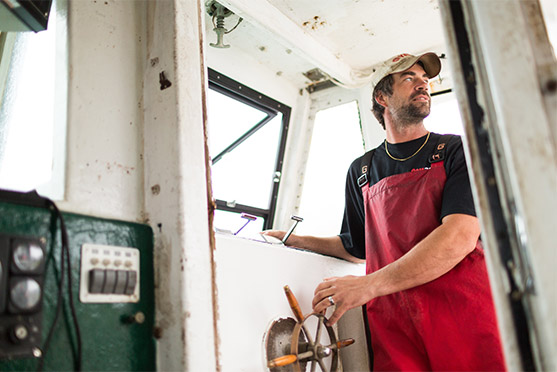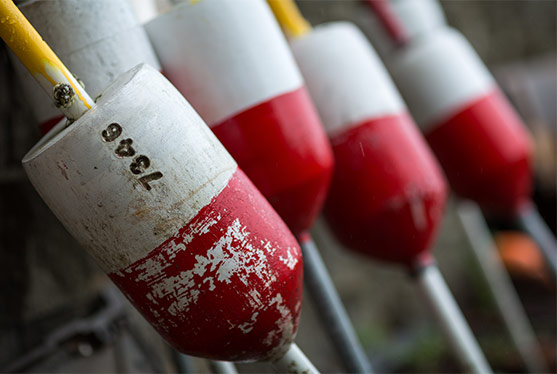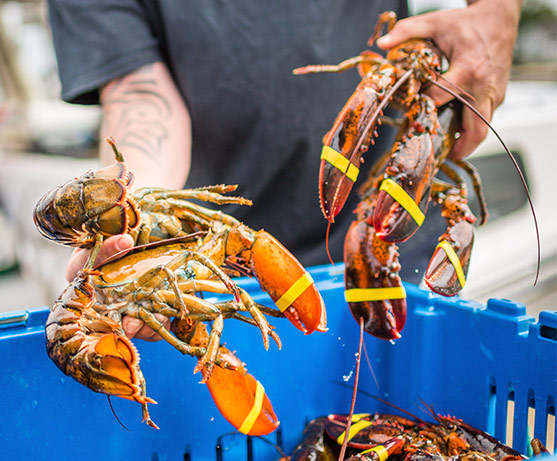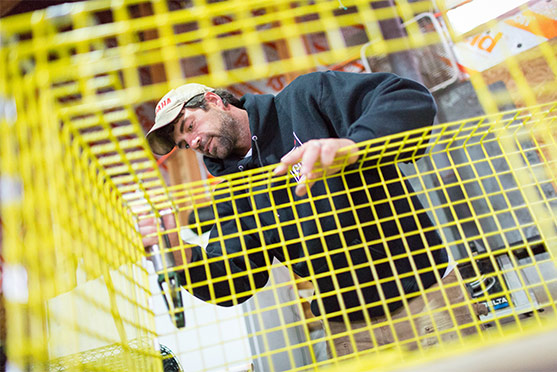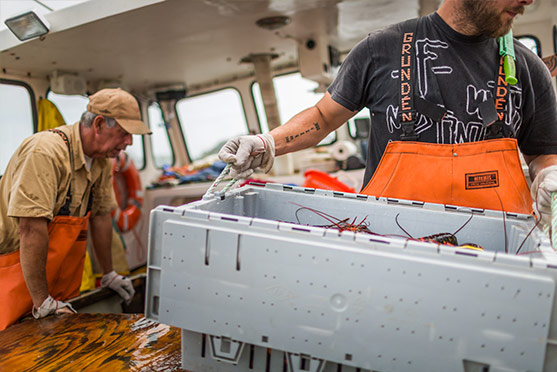To this end, the Maine lobster industry prides itself on being a model of sustainable fishing and has the credentials to prove it. Certified by the Marine Stewardship Council, the lobster industry practices sustainable fishing because it protects the ecosystem they revere and depend upon. The quest for sustainability in Maine has never been a question, but rather a promise to the next generation that lobstering will remain a viable way of life along the coast.
Lobstermen of Herman's ilk are a dwindling breed. As a fourth-generation lobsterman, he was taught his trade the old-school way. Nowadays, some younger fishermen shortsightedly place their traps in the zones known for their abundance of lobster, failing to develop their skills or understand the tempestuous whims of the sea. Herman knows this way of lobstering won't produce the same generation-spanning success as his own traditional methods, and that it's impossible to impose modern society's fixation with instant gratification on a way of life rooted in patience and hard-earned trust.
In his seminal exploration of lobstering in Maine, The Lobster Gangs of Maine, James M. Acheson delves deeply into the intricate social net connecting Maine lobstermen. He describes the complex relationship that exists between lobstermen as "an elaborate dancelike interaction in which cooperation must be balanced with competition, secrecy with openness, and sharing with self-interest," highlighting the delicate interpersonal terrain of Maine lobstermen.i Lobstermen in Maine rely on each other to stay afloat but walk a fine line between not divulging the tricks of their trade and remaining neighborly.
Lobstermen in Maine typically view the men in their own fishery as "harder working and more virtuous than those who catch other types of fish for a living."ii This kind of good-natured rivalry between fishermen is par for the course in coastal communities, where your work is an extension of yourself. The "harbor gangs" of lobstermen in Maine act as both support networks for the lobster harvesters and have developed a kind of mythic ethos surrounding their power in the community. Sub-cultures breed unspoken rules and customs, and the lobstering community in Maine is no exception. For example, if a fisherman were to set traps outside of his territory, the harbor gang whose territory had been infringed upon would exact prompt retribution. New members of harbor gangs must be voted in by the veteran lobstermen, with the most skilled fishermen becoming unofficial leaders of the gang. Lobstermen in Maine rarely interact with members of neighboring harbor gangs, as the long and craggy coast of Maine is not conducive to frequent contact between harbors. In many ways, the coasts of Maine are a modern extension of the Old West, replete with their own codes and rules that are understood and enforced outside of traditional law enforcement. The Maine lobsterman is the modern-day cowboy, patrolling the Eastern Seaboard on his trusty boat, a cry of Hi-Ho Lobster filling the air.
The lobstering community in Maine is an independent bunch, smart and savvy when it comes to the intricacies and traditions of trap placement, boat care, and navigating the open seas. Often characterized as strong-willed, independent and introverted folk, they keep to themselves while single-handedly keeping the Maine lobstering tradition afloat. Monique suggests that the best way to get a fisherman to talk is by asking about either his boats or his fish, noting that a lobsterman's boat becomes an honorary member of the family – often named after a mother or a daughter (it's considered bad luck in the lobstering community to name your boat after your wife, as they "can come and go"), a fisherman's vessel takes on its own personality.
When standing aboard a lobstering boat off of the Maine coast, the clean ocean air tousles your hair, the waves churn underneath your feet and the smell of fresh bait permeates your nostrils. The concept of linear time disappears when it's just you and the ocean. Not much has changed in the history of Maine's lobstering industry, but the changes that have affected the lobster industry in Maine are primarily the result of transportation innovation.
The lobster canneries that dotted the coast in the mid-1800s were displaced with the invention of fresh lobster transportation by rail, which was in turn made irrelevant by the invention of air shipment in the 1950s. Over the centuries, fishermen have honed their techniques, and gear tweaks have allowed for easier trap placement and hauling, but the main crux of their craft has been an unwavering respect and understanding of the ocean.
As idyllic as the industry may seem to outsiders, the lobster industry in Maine is at a crossroads.
Despite record-breaking lobster harvests resulting in what James Surowiecki of The New Yorker terms "more lobster out there right now than anyone knows what to do with," lobstermen are having difficulty just breaking even.iii There are many factors contributing to this situation, but the most dangerous divide is the growing distance between soaring overhead costs absorbed by lobstermen (who are technically considered private contractors) and plummeting per-pound dock prices netted from the day's harvest. Market prices have always fluctuated for lobster, but because of the recent unprecedented harvests, the market is glutted and the lobstermen are suffering. Couple this troubling dynamic with the usual ups and downs of lobstering and many coastal communities in Maine are wondering if their centuries-old way of life can remain viable for generations to come.
As a general rule, lobstermen like Herman have to catch at least 150 pounds of lobster per day in order to cover their bait and gas costs, and long gone are the days when a year's income could be netted from the summer season alone. So where does this leave the iconic and venerable lobster industry in Maine? The answer is ambiguous, as most responses to life's larger questions are. But one thing is for certain: Lobstermen in Maine have made it through tough times before and, having been trained on the variable moods of the sea, are nothing if not resilient to economic turbulence.
One positive result of the 2008 recession and subsequent plummeting lobster price per pound in Maine is the opportunity for more women to join the lobstermen ranks. When the demand and price for lobster fell, many captains chose not to hire sternmen, electing instead to keep the business within their families. Daughters, wives and nieces took up the helm and spawned a new generation of female lobstermen (citing the often non-politically correct world of lobstering, one female captain said she prefers to be called a lobsterman because "lobsterwoman" just doesn't have the right ring to it, and according to local convention, all lobster harvesters–regardless of gender–are referred to as lobstermen). Lobstering is hard, physically demanding work. Just look at a lobsterman's arms for visual confirmation of what it might be like to haul metal and concrete traps aboard the boat's stern all day long. The traps are about 4 feet tall and weigh approximately 40 pounds. But none of that deters Maine women from the lobstering life: When the wide-open expanses of the Atlantic call to you, you respond in kind.
With struggle comes resilience, and the Maine lobstering community has weathered many a storm. In 2008, when lobster prices reached a record low, many of the Coombs' friends and fellow fishermen found themselves jobless. Families helped families, and no one went hungry. Monique sums up the Maine lobsterman's code by saying simply
"We live in a throwback community."
Close quarters breed conflict, but Monique notes that no matter what small quarrels may exist on land, if something were to happen on the water, there's no doubt in her mind that all arguments would be forgotten. Acheson echoes Monique's sentiment, noting that if a lobsterman becomes ill, it's common practice for members of his harbor gang to pull his traps and give him the proceeds until he recovers.
When considering the lobsterman, the concept of "work-life balance" becomes murky. From an outsider's perspective, the Maine lobsterman has no work-life balance–it's all work. But coastal Mainers know that the ocean, the lobsters within its salty depths and the bond that fishermen have with their work cannot fit into the modern need for a professional-personal divide. The Maine lobsterman is a maritime farmer. He rises with the sun to tend his icy-blue field and returns home at night thinking of the next day's catch. When offshore, he tracks storm systems and exchanges information with fellow lobstermen about the weather, their haul, prices and other lobster-related news. There is no part-time lobsterman in Maine. There is no 40-hour workweek for lobstermen. There are no benefits, no 401k, no paid vacations. What there is, instead, is a complete and utter devotion to the lobstering life and the unique bond forged between man and sea.
As Herman Coombs closes his eyes at night after a long day at sea aboard his lobstering boat, his body continues to sway with the waves, the smell of saltwater fills his nose, and the topography of the ocean floor is as clear to him as his own living room. Herman plans out tomorrow's trap placement and the calls he'll need to make to sell the day's catch to area restaurants and falls asleep sure to dream of the Atlantic. He wouldn't have it any other way.
